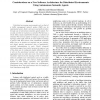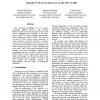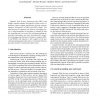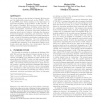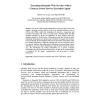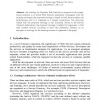108
click to vote
COMPSAC
2005
IEEE
15 years 4 months ago
2005
IEEE
Distributed processing environments such as that of a traffic management network system (TMS) can be implemented easier, faster, and secure and perform better through use of auton...
101
click to vote
IAT
2006
IEEE
15 years 5 months ago
2006
IEEE
This paper addresses the dynamic service selection and composition issues for the satisfaction of user requirements. We propose an approach in which agents perform service composi...
HICSS
2006
IEEE
15 years 5 months ago
2006
IEEE
The increasing availability of web services necessitates efficient discovery and execution framework. The use of xml at various levels of web services standards poses challenges t...
HICSS
2006
IEEE
15 years 5 months ago
2006
IEEE
This paper describes how we manage the interaction between different heterogeneous web services through choreographies within IRS-III. IRS-III is a framework and platform for deve...
AICT
2006
IEEE
15 years 5 months ago
2006
IEEE
Semantic Web Services frameworks like OWL-S and WSMO combine semantic descriptions of Web service capabilities, inputs, outputs and behavior with the syntactic interface descripti...
126
click to vote
VLDB
2007
ACM
15 years 5 months ago
2007
ACM
The recent upsurge in the interest in Semantic Web services and the high-profile projects such as the WSMO, OWLS, and SWSL, have drawn attention to the importance of logic-based ...
SOCASE
2007
Springer
15 years 5 months ago
2007
Springer
The need to add semantic information to web-accessible services has created a growing research activity in this area. Standard initiatives such as OWL-S and WSDL enable the automat...
115
click to vote
OTM
2007
Springer
15 years 5 months ago
2007
Springer
As more semantic web services become on the Internet, it is feasible that users collaborate among them to save efforts in complex web solutions by sharing and reusing existing sema...
HPCC
2007
Springer
15 years 5 months ago
2007
Springer
An ontology for Semantic Web Services is proposed in this paper, whose intention is to enrich Web Services description. Distinguish from the existing ontologies, the proposed ontol...
GI
2007
Springer
15 years 5 months ago
2007
Springer
Abstract: Governmental processes are complex and knowledge-intensive. Most process management systems fail to support them in an adequate way. On the other hand semantic technologi...
